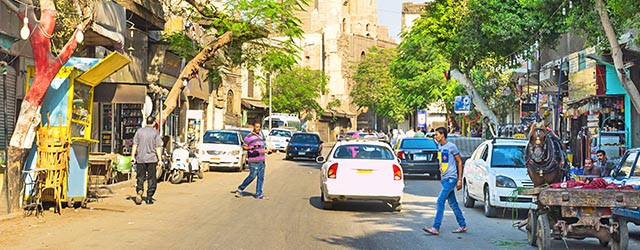Some green shoots lurk beneath the region’s raging civil wars, economic woes and political unrest.

“Hey you, don’t tell me there’s no hope at all. Together we stand, divided we fall,” sang Roger Waters in The Wall, a movie released globally September 29 to honor the victims of Syria’s brutal civil war.
Waters’s lyrics weren’t about the Levant—Pink Floyd’s recording “The Wall” was first performed 36 years ago—but as Syrian refugees flood Europe and walls go up to keep them out, the words couldn’t be more appropriate.
The state of most of the region appears to be going from bad to worse in 2015. Civil wars rage in Syria and Iraq, and tensions have risen to unprecedented levels in neighboring Jordan and Lebanon, which are struggling to host refugees equivalent to at least one-fourth of their respective populations. Looking westward, Cyprus is trying to emerge from the worst financial crisis in its history with unemployment at 17%, bank nonperforming loans at around 46% of the total, and public debt close to 100% of GDP.
In Egypt the government of president Abdel Fattah el-Sisi is still grappling with the legacy of the deposed Islamist government, with efforts to rebuild hampered by political divisions and terrorist attacks that have undermined efforts to revive the all-important tourism industry.
Confidence is fragile everywhere, which means much-needed foreign investment is staying away.

“As long as the conflicts in Syria and Iraq continue, there is little chance that their economies will return to pre-conflict levels. Conflicts have made intra-Levant trade more complicated, with the closure of border points between Syria, on one hand, and Iraq and Jordan on the other. The drop in oil prices is not helping Iraq, while the war in Syria has transformed it into a war economy. Meanwhile, Jordan and Lebanon have suffered from spillovers of the conflict and from a decline in investor confidence,” says Nassib Ghobril, chief economist at Byblos Bank.
“There has been no tangible progress towards improving stability, much-needed reforms have not been initiated, and growth has been sluggish to nonexistent,” agrees Ayham Kamel, senior analyst for the Levant for the Eurasia Group.
ENERGY COMPLICATIONS
Kamel warns that support from the oil- and gas-rich Gulf states—which has been key in helping many of the Levant states stay afloat during such difficult times—is likely to become more scarce as low energy prices persist. And the offshore energy bonanza from the Levantine Basin that Lebanon, Cyprus and Egypt have been keenly expecting, which will help reducebudget and current-account deficits, has been held back by political infighting, geopolitical disagreements and technical complications.
Yet, if one scratches the surface, the picture below looks a bit more promising.
Being net importers of energy, all Levantine countries except Iraq have benefited from low oil prices. Overall, the financial sector has remained surprisingly robust, experts say, and the number of nonperforming loans has been kept in check. Each nation has reason for hope.
Lebanon has been struggling to keep out of the Syrian war, and its fragile political consensus has neared breaking point, owing to Hezbollah’s military support of Syria’s president Assad and the absence of a president for more than a year.

September’s demonstrations in Beirut over uncollected garbage evolved into protests for more-effective government. Among the administration’s unfinished business is legislation enabling it to exploit its off-shore energy reserves and reform of the heavily indebted, grossly inefficient national electricity company, EDL. Lebanon’s crisis has affected banks’ local operations. Private-sector lending has declined from $2.2 billion in the first half of 2014 to $924 billion in the first half of 2015.
“This is the result of low consumer confidence and reduced investor sentiment and the lack of FDI projects because of persisting uncertainties and high operating costs. In parallel, the banks are facing the prospects of higher borrowing needs from the public sector due to the lack of political will to reduce expenditures and fight tax evasion,” says Ghobril. He thinks banks should use their financial leverage to force the government to tackle corruption and waste. Bankers, however, seem to have found a way around the problems.
FINANCIAL FITNESS
“Across the Levant there seems to be a disconnect between reality and the financial sector—which, by contrast, seem quite healthy,” says Freddie Baz, group strategy director at Bank Audi.
Although domestic GDP growth this year will be around zero—down from the modest 1% to 2% recorded over the past few years, with the economy reckoned to be operating at only 75% of capacity—he notes that non-performing loans have not deteriorated as much as some had feared.
He says Bank Audi has outperformed thanks to an uptick in its Levantine operations, specifically Egypt, where assets grew 18% in the first half of 2015 from 31 billion Egyptian pounds ($4) to 36.7 billion Egyptian pounds ($4.7) and Turkey (where assets grew 13% to 28.4 billion Turkish liras ($9.7 billion). Baz says targeting expansion in key countries—an approach emulated by other Lebanese banks—has enabled them to grow despite “the very difficult operating environment in all these countries.”
“In just two and a half years we have come from nowhere in Turkey to be the 12th-largest of the 36 banks there—all this purely through organic growth and not acquisition,” he says.
Another growth area for Bank Audi (and other Lebanese banks) is private banking, which despite, or perhaps because, of the region’s ongoing crisis, is booming. Baz has ambitions to add $6 billion to $7 billion to the bank’s existing $11 billion in private banking assets by the end of 2020.
Conflicts have made intra-Levant trade more complicated, with the closure of border points between Syria, on one hand, and Iraq and Jordan, on the other.
~ Nassib Ghobril, Byblos Bank
BLOM Bank can boast of a similar success story, with net profit reaching $190.4 million in June 2015, up by 6.2% over 12 months. Assets rose 4.6% to $28.6 billion, and loans grew 3.9% to $7.1 billion. However, it has shifted activity toward other Levantine countries and Europe. Lebanon now accounts for just 67% of net profit, against 88% four years ago.
“Our strategy in achieving these results has been to adhere to a conservative policy that emphasizes risk control, asset quality and adequate capital and liquidity,” says BLOM Bank chairman Saad Azhari.
Cyprus also has a positive story to tell, after the tribulations of recent years, having recorded growth in each of the first two quarters of 2015. The country is expected to register positive GDP growth of 0.5% this year, rising to 1.5%, suggesting the contraction that followed the financial crisis of 2012 to 2013 is now past. Altogether, the economy will have contracted 10%, far short of the 20% to 25% some economists were predicting.
Meanwhile, negotiations over a solution to the decades-old Cyprus problem continue between Greek and Turkish Cypriots, with both sides eager for a deal that would provide an unprecedented boost to the island’s economy. Given the political uncertainty in Turkey, however, few observers are holding their breath.
NEW MODEL
The search is on for a new growth model to replace the discredited construction-based one. The model will probably be defined by high-end tourism, high-value-added manufacturing and information and communications technology.
Amid signs the financial sector is returning to normal after the collapse of Laiki Bank in 2013, capital controls have been lifted, and the Troika (European Central Bank, European Commission and IMF) and the European Bank for Reconstruction and Development (EBRD) are focusing on boosting bank liquidity—and lending to SMEs in particular.
Standard & Poor’s recently upgraded its sovereign rating for Cyprus to BB- with a positive outlook. “Fundamentals look good as the government follows through with some tough decisions, including wage and spending cuts, whilst structural reform looks to be on track,” says Peter Sanfey, acting director of country strategy and policy at the EBRD.
In September, the EBRD—which is investing in Cyprus until end-2020, focusing on the financial sector, privatization and loans to small businesses—took a 5.4% equity stake in Hellenic Bank, the country’s second-largest bank. The €20 million ($23 million) it has invested will enable Hellenic Bank to play a more prominent role in Cyprus’s recovery, and follows last year’s decision by the EBRD to invest some €120 million in Bank of Cyprus as part of its €1 billion capital increase.
The EBRD has also played a constructive role in Jordan. In early October the organization announced it would provide high-level judicial training in connection with Amman’s ambitious plans to improve the investment environment. To date, the bank has invested some $500 million across 25 projects in the economy.
There has been no tangible progress towards improving stability, much-needed reforms have not been initiated, and growth has been sluggish to nonexistent.
~ Ayham Kamel, Eurasia Group
MIXED MESSAGE
If ever a country was cursed by geography, it is Jordan, bordering as it does on Syria and Iraq. Tourism should be one of its biggest revenue earners. Major projects are ongoing in and around the port city of Aqaba, attractions such as the ancient city of Petra, and the dramatic desert landscape of Wadi Rum (which doubles for Mars in the movie “The Martian”) used to attract as many as 10 million visitors a year before 2010.
Last year, total numbers were down to half that. Over 2015, many expect another 40% drop from that following the June terrorist attack in Tunisia (even though it is hundreds of miles away). GDP growth this year will be at best 3.5%, below the 4% to 5% needed to sustain employment levels—which, in turn, is key to maintaining political stability.
Heike Harmgart, the EBRD’s director for Jordan, says that pharmaceuticals, information and communications technology and phosphates are all buoyant sectors, as are energy—solar energy is a fast-growing industry in this hot country that depends on fossil fuel imports—and the financial sector.
“Jordan’s 26 banks are very liquid, have high deposit levels, and are well-regulated,” she says. “The priority is to encourage them to boost long-term lending to SMEs so they can play a bigger role in Jordan’s development, and we are doing what we can to facilitate this.”
Yet no one doubts that the Levant’s numerous problems will continue to overshadow the efforts of individual countries to boost growth and investment. Going forward, determination and resilience will be key to these countries’ eventual recovery.
|
Country |
GDP (%change), constant prices |
GDP (%change), constant prices |
GDP current prices ($bn) |
Inflation |
FDI inflows |
|---|---|---|---|---|---|
|
2014 |
2015 |
2014 |
2014 |
2014 |
|
|
Cyprus |
-2.3 |
0.5* |
23.3 |
-0.3 |
679 |
|
Egypt |
2.2 |
4.2* |
286.4 |
10.1 |
4,783 |
|
Israel |
2.5 |
2.5* |
305.7 |
0.5 |
6,432 |
|
Jordan |
3.1* |
2.8* |
35.9* |
2.9* |
1,760 |
|
Lebanon |
2.0* |
2.0* |
50.0* |
1.9* |
3,070 |
Source: GFMag.com economic reports, IMF, UNCTAD
*Estimate



